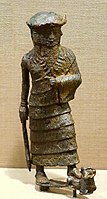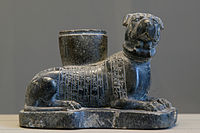Isin-Larsa period
Isin-Larsa period | |||||||||||
|---|---|---|---|---|---|---|---|---|---|---|---|
| c. 2025 BCE – c. 1763 BCE | |||||||||||
MC ) | |||||||||||
• Disestablished | c. 1763 BCE (MC) | ||||||||||
| |||||||||||
| Today part of | |||||||||||
The Isin-Larsa period (c. 2025–1763 BCE,
The Third Dynasty of Ur immediately preceded the Isin-Larsa period, and its fall was due to the combined attacks of the
Isin as the main polity (2025–1924 BCE)

When the deteriorating Third Dynasty of
Although he is not considered to be a part of the Third Dynasty of Ur, Ishbi-Erra did make some attempts at continuing the trappings of that dynasty, most likely to justify his rule.[4] Ishbi-Erra had ill luck expanding his kingdom, however, for other city-states in Mesopotamia rose to power as well—Eshnunna and Ashur were developing into powerful centers. However, he did succeed in repulsing the Elamites from the Ur region. This gave the Isin dynasty control over the culturally significant cities of Ur, Uruk, and the spiritual center of Nippur.
For over 100 years, Isin flourished. Remains of large building projects, such as temples, have been excavated. Many royal edicts and law-codes from that period have been discovered. The centralized political structure of Ur III was largely continued, with Isin's rulers appointing governors and other local officials to carry out their will in the provinces. Lucrative trade routes to the Persian Gulf remained a crucial source of income for Isin.
Rise and dominance of Larsa (c. 1924–1763 BCE)
The city of Larsa had been subject to the city of Lagash, which had been captured by the Isin ruler
The exact events surrounding Isin's disintegration as a kingdom are mostly unknown, but some evidence can be pieced together from the historical and archaeological record. For Gungunum to legitimize his rule and deliver a blow to Isin, he captured the city of Ur. As the region of Larsa was the main center of trade via the Persian Gulf, Isin had lost access to enormously profitable trade routes. Ur was a city with tremendous historic and cultic significance; at some point, another cultic center, Nippur, was also lost. Documents also indicate that Isin had a huge problem maintaining access to its water sources. Gungunum's two successors, Abisare (c. 1841–1830 BCE) and Sumuel (c. 1830–1801 BCE), both took steps to completely cut off Isin's access to canals by rerouting them into Larsa.
Larsa grew powerful, but never accumulated much territory. At its peak, under king
Around 1860 BCE, an outsider named Enlil-bani seized the throne of Isin, ending the hereditary dynasty established by Ishbi-Erra over 150 years earlier.[5]
Demise
Art
Artistically, the Isin-Larsa period is a period of turmoil, marked by the rise of the influence of the
-
Four-faced god, Ishchali, Isin-Larsa to Old Babylonia periods, 2000–1600 BCE, bronze - Oriental Institute Museum, University of Chicago
-
-
A praise poem toMusée du Louvre
-
List of the kings of Larsa,Louvre Museum.
-
Votive statuette of a dog, dedicated by a doctor fromSûmû-El, king of Larsa. Musée du Louvre.
-
Ceramics from the Isin-Larsa period. Museum of Oriental Institute of Chicago
-
Terracotta male figurine holding an axe or adze, from Tell Telloh, Isin-Larsa period, c. 1900 BCE. Iraq Museum
References
- ^ ISBN 978-0-300-06470-4.
- ^ ISBN 978-1-58983-106-3.
- ^ ISBN 978-0-300-06470-4.
- ^ a b Vaughn E. Crawford, An Ishbi-Irra Date Formula, Journal of Cuneiform Studies, vol. 2, no. 1, pp. 13–19, 1948
- ^ William W. Hallo, The Last Years of the Kings of ISIN, Journal of Near Eastern Studies, vol. 18, no. 1, pp. 54–72, 1959
- ^ W. G. Lambert, "The Home of the First Sealand Dynasty", Journal of Cuneiform Studies, 26 (1974), pp. 208–210
- ISBN 978-0-300-06470-4.








